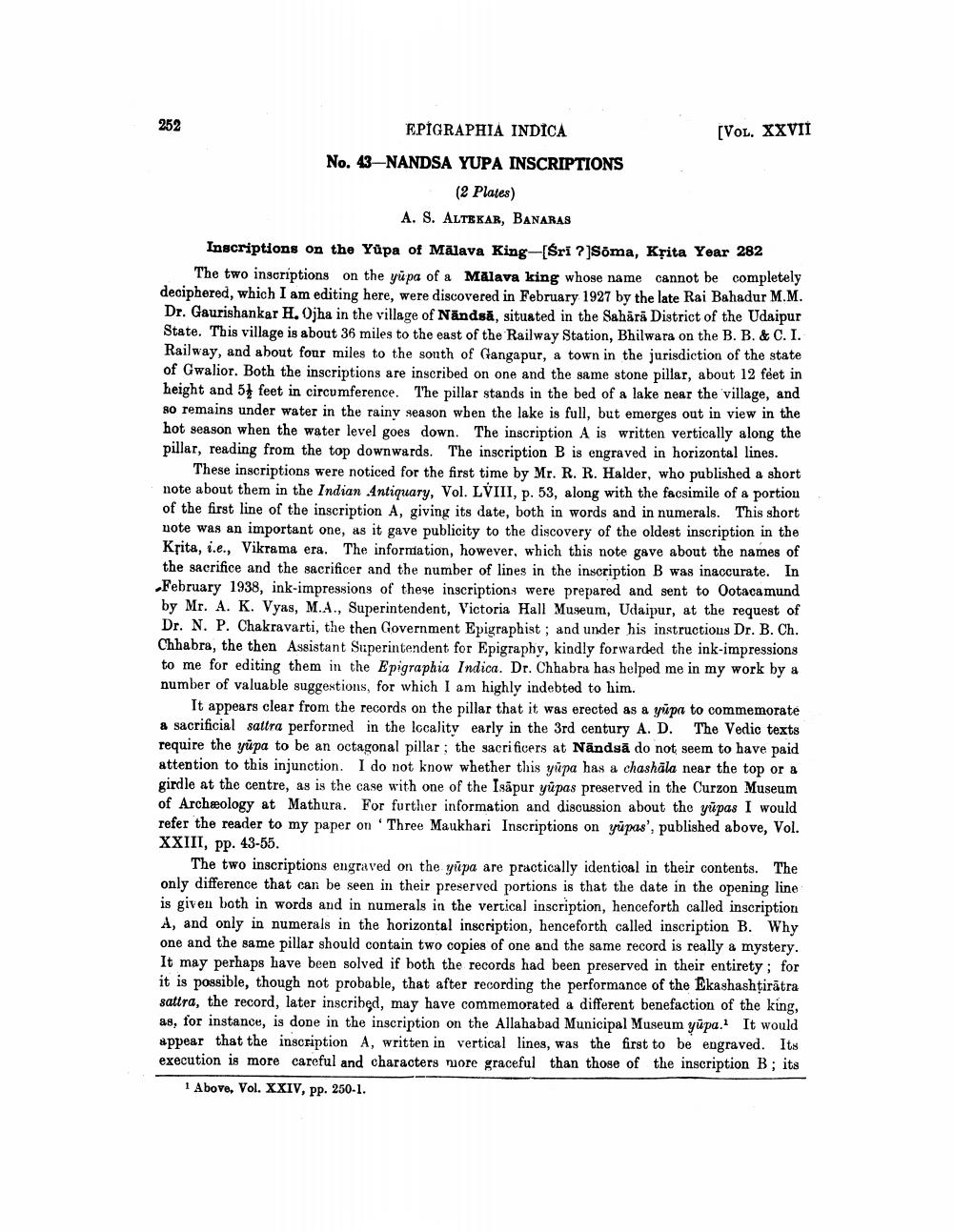________________
252
EPIGRAPHIA INDICA
(VOL. XXVII
No. 43-NANDSA YUPA INSCRIPTIONS
(2 Plates) A. S. ALTEKAR, BANARAS
Inscriptions on the Yüpa of Malava King-[Śri ?]Söma, Ksita Year 282
The two inscriptions on the yüpa of a Malava king whose name cannot be completely deciphered, which I am editing here, were discovered in February 1927 by the late Rai Bahadur M.M. Dr. Gaurishankar H. Ojha in the village of Nändsă, situated in the Sahara District of the Udaipur State. This village is about 36 miles to the east of the Railway Station, Bhilwara on the B. B. & C. I. Railway, and about four miles to the sonth of Gangapur, a town in the jurisdiction of the state of Gwalior. Both the inscriptions are inscribed on one and the same stone pillar, about 12 feet in height and 54 feet in circumference. The pillar stands in the bed of a lake near the village, and 80 remains under water in the rainy season wben the lake is full, but emerges out in view in the hot season when the water level goes down. The inscription A is written vertically along the pillar, reading from the top downwards. The inscription B is engraved in horizontal lines.
These inscriptions were noticed for the first time by Mr. R. R. Halder, who published a short note about them in the Indian Antiquary, Vol. LVIII, p. 53, along with the facsimile of a portion of the first line of the inscription A, giving its date, both in words and in numerals. This short note was an important one, as it gave publicity to the discovery of the oldest inscription in the Krita, i.e., Vikrama era. The information, however, which this note gave about the names of the sacrifice and the sacrificer and the number of lines in the inscription B was inaccurate. In February 1938, ink-impressions of these inscriptions were prepared and sent to Ootaca mund by Mr. A. K. Vyas, M.A., Superintendent, Victoria Hall Museum, Udaipur, at the request of Dr. N. P. Chakravarti, the then Government Epigraphist; and under his instructions Dr. B. Ch. Chhabra, the then Assistant Superintendent for Epigraphy, kindly forwarded the ink-impressions to me for editing them in the Epigraphia Indica. Dr. Chhabra has helped me in my work by a number of valuable suggestions, for which I am highly indebted to him.
It appears clear from the records on the pillar that it was erected as a yüpa to commemorate a sacrificial sattra performed in the locality early in the 3rd century A. D. The Vedic texts require the yüpa to be an octagonal pillar ; the sacrificers at Nändsă do not seem to have paid attention to this injunction. I do not know whether this yüpa has a chashāla near the top or a girdle at the centre, as is the case with one of the Isāpur yüpas preserved in the Curzon Museum of Archeology at Mathura. For further information and discussion about the yūpas I would refer the reader to my paper on 'Three Maukhari Inscriptions on yüpas', published above, Vol. XXIII, pp. 43-55.
The two inscriptions engraved on the yüpa are practically identioal in their contents. The only difference that can be seen in their preserved portions is that the date in the opening line is given both in words and in numerals in the vertical inscription, henceforth called inscription A, and only in numerals in the horizontal inscription, henceforth called inscription B. Why one and the same pillar should contain two copies of one and the same record is really a mystery. It may perhaps have been solved if both the records had been preserved in their entirety : for it is possible, though not probable, that after recording the performance of the Ekashashţirātra sattra, the record, later inscribed, may have commemorated a different benefaction of the king, as, for instance, is done in the inscription on the Allahabad Municipal Museum yūpa. It would appear that the inscription A, written in vertical lines, was the first to be engraved. Its execution is more careful and characters more graceful than those of the inscription B ; its
1 Above, Vol. XXIV, pp. 250-1.
49.55




